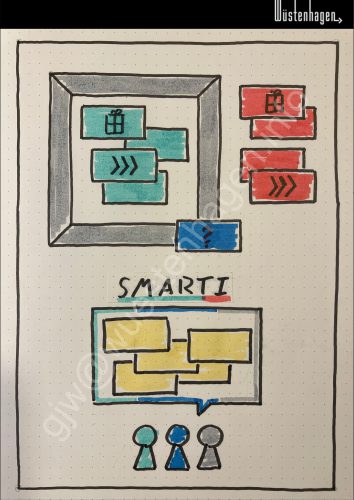Projektmanagement@GJW
DE
SMART und In/Out Rahmen
Warum: Den Umfang des Projektes mit den Beteiligten auf ein realistisches Maß abstimmen, verankern und erinnern.
.
Wie: Im >Definieren< moderiert abstimmen und verankern; im >Planen< finalisieren; im >Durchführen< und >Abschließen< zum Halten des Projekt-Fokus erinnern.
.
Was: Aufbauend auf der Visualisierung des Problems kann das Ziel SMART (spezifisch, messbar, abgestimmt, realistisch und terminiert) beschreiben werden. Die fünf Begriffe sind leicht gesagt – doch wie stellen Sie sicher, dass Ihre Beschreibung diesem Anspruch gerecht wird? Dabei hilft der In/Out-Rahmen kombiniert mit Fragen nach:
- Was ist das Problem und was ist nicht das Problem?
- Was ist das Projekt-Ergebnis, der Liefergegenstand, das Deliverable und was nicht?
- Wer sind die Nutzenden des Projektergebnisses und wer nicht?
- was ist die weitere Verwendung des Projektergebnisses und was nicht? Hier lösen sich oft Missverständnisse über die erwartete Qualität des Projektergebnisses auf. Es ist ein Unterschied, ob ein Prototyp als Handmuster dient, für Tests im Technikum oder für Tests im Feldeinsatz.
Das I (für ignorieren) in SMARTI steht dafür, die Projektbeteiligten immer wieder daran zu erinnern, dass Aspekte gegeneinander abgewogen werden müssen. Oft klären die Aspekte im >Out< für alle Beteiligten den wahren Umfang. Fällt die Einigung auf >In< und >Out< zu schwer, kann der Multi-Generationen-Plan helfen.
EN
SMART and In/Out Frame
Why: Aligning the scope of the project with stakeholders to a realistic level, anchoring it, and reminding them.
.
How: Moderating alignment and anchoring in >Define<; finalizing in >Plan<; reminding to maintain project focus during >Execute< and >Close<.
.
What: Building on the visualization of the problem, the goal can be described as SMART (specific, measurable, agreed upon, realistic, and time-bound). These five terms are easy to say – but how do you ensure that your description meets this standard? The In/Out framework combined with questions such as:
- What is the problem and what is not the problem?
- What is the project outcome, deliverable, and what is not?
- Who are the users of the project outcome and who are not?
- What is the further use of the project outcome and what is not? This often resolves misunderstandings about the expected quality of the project outcome. There is a difference between a prototype serving as a hand sample, for testing in the lab, or for field testing.
The I (for ignore) in SMARTI stands for reminding project participants that aspects need to be weighed against each other. Often, aspects clarified in the >Out< help all stakeholders understand the true scope. If agreement on >In< and >Out< is difficult, the Multi-Generational Plan can help.
Geplante/Erforderliche Verbesserungen
tbd
